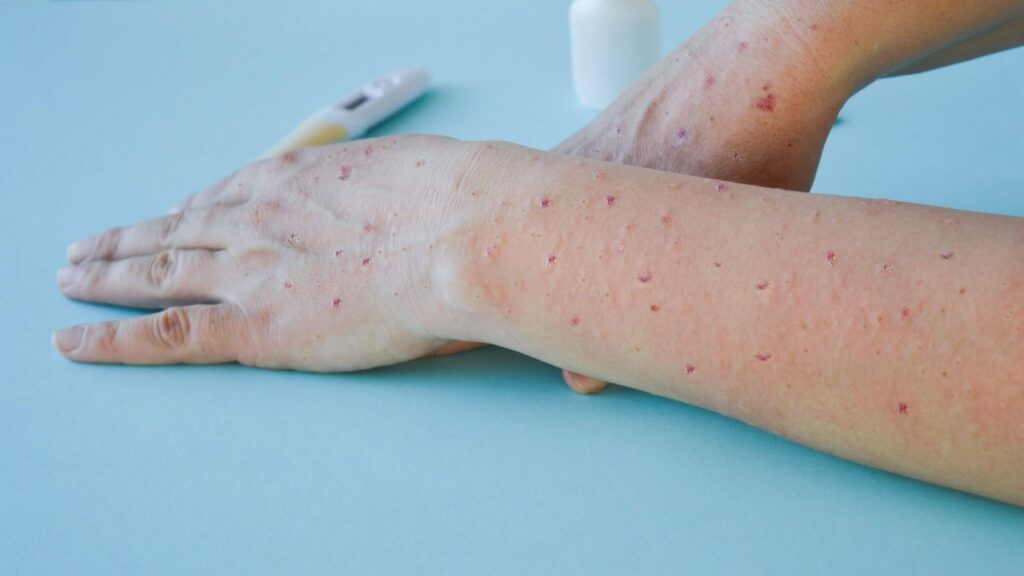Monkeypox is a rare disease that has occurred predominantly in the countries of West and Central Africa in recent decades. The special thing: Monkeypox is currently spreading worldwide – already, twelve countries have registered the infectious disease, including Great Britain, Spain, Portugal, Italy, the United States and Germany. Here’s how Monkeypox is transmitted and what the typical symptoms of infection are.
Table of Contents
Every day new cases: The cause of Monkeypox
While in the United States, there are currently a few known cases, the number of new Monkeypox infections is increasing, especially in Great Britain and Spain. According to the British government, new cases are reported daily.
The underlying causes of the current infections have not yet been definitively clarified. Initial speculation suggests that the disease may have been spread during a large Pride parade on the Spanish island of Gran Canaria.
Monkeypox is a rare viral disease (Monkeypox virus, genus Orthopoxvirus), usually transmitted by rodents. Usually, this occurs through contact with skin florescences (skin blooms), blood, tissues or excretions of already infected animals or the handling and consumption of corresponding meat. Monkeypox owes its name to Danish researchers who first discovered the virus in a monkey in 1958.
Human-to-human infection is rare, but it can be transmitted through close contact, for example, through Monkeypox body fluids or scabs (dead skin tissue), likewise in the context of sexual activity. It can also be transmitted via the respiratory tract during the preliminary phase of the disease.
Symptoms of Monkeypox
The incubation period, that is, the time between infection and outbreak of the disease, can last between 7 and 21 days. In the following, we will talk about some of the Monkeypox symptoms,
Monkeypox: A high fever is an initial symptom
A high fever is a symptom of Monkeypox. It increases suddenly and rapidly up to 40 degrees Celsius in most cases. Fever is just one of many other signs of Monkeypox infection…
Rash: a symptom of Monkeypox
A skin rash may appear about one to three days after the fever and other symptoms. It usually starts on the patient’s face and then affects other parts of the body, for example, the palms of the hands or soles of the feet.
However, skin changes can also occur in the genital area and mucous membranes. Initially, red spots appear on the skin, turning into blisters and filling with pus. A crust forms after a few days.
Headaches are a symptom of Monkeypox
Besides fever, a severe headache also occurs during the first few days of infection. Fever-reducing medications and painkillers can help relieve initial discomfort. For prevention, there is a vaccine against the virus itself. The drug Tecovirimat also serves as a specific medication in severe cases.
Pain in the limbs and muscles: A symptom of Monkeypox
In addition to headaches, Monkeypox can also cause limb and muscle pain. In particular, low back pain is common in association with Monkeypox. Pain medications can also help to relieve this discomfort.
Swelling of the lymph nodes is a symptom of Monkeypox.
Visible swelling of the lymph nodes is also possible with Monkeypox. In many cases of the disease, the lymph nodes in the neck region mainly swell up. But the lymph nodes of the armpits or in the groin area may also be affected.
Monkeypox cough and sore throat: rare symptoms.
Cough and sore throat may also occur in some cases of Monkeypox. Rhinitis, however, has not been observed as a symptom to date.
Symptoms of Monkeypox: Exhaustion
Affected people with Monkeypox often suffer from exhaustion (asthenia) and severe fatigue. As a rule, all the symptoms subside in a few weeks. Superinfections of the skin rashes and pneumonia or meningitis can be prevented by prompt medical attention.
Just how dangerous is Monkeypox?
According to researchers, infection with viral disease is a severe illness. Especially children, older people and people with immune deficiencies are at risk. In addition, there is a risk that pregnant women can transmit the virus to their unborn children, with possible consequences such as pregnancy complications and miscarriages.
As the immune system is already weakened, so-called superinfection by bacteria can occur. This can lead to pneumonia or meningitis and infection of the cornea and thus to blindness.
Furthermore, Monkeypox must be distinguished between different virus types:
- Western African type: with this type of virus, mortality is lower (1 percent) but leads to severe illness in some individuals.
- The Congo Basin type: the mortality rate for this type is approximately 10 percent.
According to initial reports, however, the diseases from Great Britain that have occurred so far are due to the West African type of Monkeypox.
Treatment and therapy of Monkeypox
Researchers say that vaccination against the original smallpox disease should protect up to 80 percent against Monkeypox infection. In addition, a treatment for the viral disease (Tecovirimat) has been approved in the European Union. The RKI also recommends preventing a possible bacterial superinfection of the pimples. As a rule, Monkeypox heals on its own, though.
Diagnosing Monkeypox
If a case of Monkeypox is suspected, an initial history will include questions about the following:
- Was the infected person in an endemic area (West and Central Africa)?
- Has the infected person had close contact with travelers?
- Has the infected person had close contact with infected persons?
Other diseases, for example, chickenpox, herpes zoster and syphilis, should also be ruled out.
Monkeypox is detected in the acute phase of the disease using a PCR test. For this purpose, blister fluid, purulent fluid, or smallpox scabs are used. Detection of antibodies is difficult using laboratory diagnostics.
Protecting against possible Monkeypox infection
To protect against smallpox infection, avoid close contact with or consumption of infected animals. In addition, safe hygiene measures should be followed when handling infected individuals, and rapid isolation and contact tracing of potentially ill individuals should be undertaken. A modified vaccine against smallpox has already been approved in the European Union.
Also Read:
